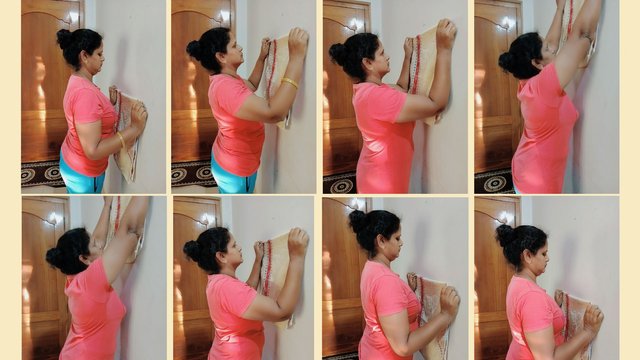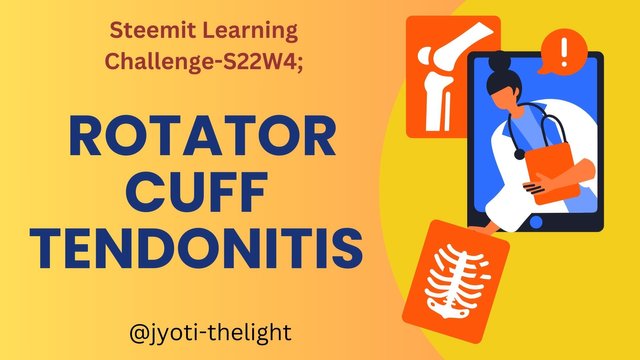Steemit Learning Challenge-S22W4; Rotator Cuff Tendonitis
Hi friends,
I am Jyoti from India. Here I am going to participate in the SLC S22 W3 contest: https://steemit.com/law-s22w3/@anasuleidy/slc22-w3-derechos-humanos-ddhh organised by @anasuleidy
What's rotator cuff tendonitis? Write in your own words after getting knowledge from the lesson post.
The first thing you need to know is your rotator cuff, this nifty group of muscles and tendons, specifically the supraspinatus, infraspinatus, teres minor, and subscapularis. It plays an important role in stabilizing our shoulder joint. They help us lift our arms and carry out our daily tasks with ease. However, when these tendons become inflamed, we develop tendonitis in the rotator cuff.
What Causes Rotator Cuff Tendonitis?
Overuse: Engaging in repetitive activities that require overhead motions can strain the rotator cuff. Think tennis serves or swimming strokes.
Sudden Injury: A fall or an awkward movement can lead to sudden trauma that triggers tendonitis.
Sports Participation: Certain sports like tennis and swimming can put extra stress on your shoulder joints.
Aging: As we grow older, our tendons naturally wear down, making them more susceptible to inflammation.
Poor Posture: If you slouch at your desk all day or have an ergonomically incorrect workstation setup, your shoulders can bear the brunt of it.
Recognizing the Symptoms
So how do you know if you're dealing with rotator cuff tendonitis? Keep an eye out for these telltale signs:
Pain and Tenderness: You might feel discomfort around your shoulder and upper arm—especially when lifting or reaching.
Swelling or Redness: Inflammation can sometimes lead to visible swelling or even redness over the affected area.
Weakness: Feeling weaker than usual? That could be due to reduced strength in your shoulder.
Clicking Sensation: Some people report a clicking or snapping feeling when moving their shoulder joint.
Limited Range of Motion: Stiffness can make it tough to move your arm as freely as before.
How would you diagnose rotator cuff tendonitis? Any clinical investigation or assessment tests? ( Don't add treatment to this question)
Now that we’ve set the stage, let’s explore how healthcare professionals go about diagnosing this condition. It usually involves several steps:
1. Taking Your History
First things first—your doctor will want to know all about you! This includes your family history (hey, genetics play a role), any past medical issues, and details about your occupation. Are you lifting heavy boxes for a living? Or maybe you’re an avid tennis player? All of this information can help pinpoint the cause of your shoulder woes.
2. Physical Examination
Next up is a thorough physical examination. Either a physician or a physical therapist will assess your shoulder's range of motion and strength. They'll look for pain points and see how well you're able to move your arm. This step is crucial in understanding the extent of the issue.
3. Imaging Tests
If you suspect tendonitis Imaging testing may be in order. X-rays can help identify the arthritis or osteoporosis that is causing your discomfort. Ultrasound is useful in visualizing tendon ruptures, while MRI shows extensive muscle damage. These tools helped him get a clearer picture of what was going on inside his shoulder!
4. Arthroscopy
In some cases, if other methods don’t provide enough information, doctors may opt for arthroscopy—a minimally invasive procedure where a small camera is inserted into the shoulder joint. This allows them to directly visualize the tendons and surrounding structures.
Special Tests in Physiotherapy
Physical therapists also have some special tricks up their sleeves when it comes to confirming the diagnosis of rotator cuff tendonitis:
Neer Test: This test checks for subacromial impingement by raising your arm while stabilizing your scapula.
Hawkins Kennedy Test: Another impingement test where your arm is raised at a 90-degree angle and rotated.
Jobe's Test: This one assesses the strength or tear of the supraspinatus tendon—an important part of the rotator cuff.
Speed Test: Here, they check for biceps tendon issues by having you resist downward pressure on an outstretched arm.
Yergason Test: Similar to the Speed Test but focuses more on assessing biceps tendon pathology.
These special tests are designed to pinpoint exactly where the problem lies and guide treatment options effectively.
Try to practice at least 3 exercises that you have learned from the lesson. Share images, gifs or videos while practicing preferably gifs or videos.
Scapular Squeeze
To do this test, I sat on a stone with my arms folded and facing forward. Then I sketched my shoulder and back backward, then slowly stretched forward. I did this several times.
Cross Body Shoulder Stretch
To practice this, I stood up, first keeping my arms straight, then folded my left hand over my shoulder and pressed it towards my right side. I pressed the stick towards my chest with my right hand. Similarly, I folded my right hand and pressed it with my left hand. I did this exercise several times.
Walk Slides
.jpg)
For this exercise, I took a towel in my hand and stood parallel to the wall, holding both ends of the towel in both hands and standing against the wall. Then I raised the towel slightly upwards by dragging. I felt my arms and the skin of my groin stretch . I did this exercise several times.
Share your review after performing these exercises either on yourself, a healthy individual or a patient.
I am a graphic designer and spend a lot of time online and at least 2 hours a day on Steemit, so I have to work sitting in a chair for a long time. Sometimes I have back pain due to spending time on computer, also feel pain spinal cord and also pain in the neck area. When I did the above exercises, I felt relief. I have been doing these exercises for two to three days, so now my pain has reduced and I feel like my back and neck areas are free.
I would like to invite my friends
@arshani ,
@nancy0 ,
To take part this contest
Discord : @jyoti-thelight#6650 Telegram :- https://telegram.org/dl

.jpg)

.jpg)

Thank you for understanding the lesson and sharing your assignment; I hope that you will enjoy this week's lesson and try to implement it in your life if you see any such case.
Observations
Task 1 (2.7/3)
You have shared a great knowledge about rotator cuff tendonitis, its symptoms, causes but you didn't add it's stages. A bit more depth require to complete the answer. I appreciate your effort.
Task 2 (2.8/3)
In the second question, you tell us about how you have to assess a patient by doing physical examination, history taking, special tests and investigations. But it would be better to add the explanation of special tests like how we perform these tests on patient. Great.
Task 3 (4/4)
You try the wall slides, cross body shoulder stretch, and scapula squeeze. You did the wall slides, cross body shoulder stretch, and scapula squeeze correctly. Always remember to apply heat pack in chronic condition and ice pack in acute condition before performing exercises to relax the muscles and reduce stiffness. I appreciate your efforts.
Overall you made a great attempt to answer all the questions. I appreciate your efforts. But next time try to avoid the above written suggestions. Keep learning and try to implement your knowledge to the people suffering from rotator cuff tendonitis or any type of shoulder issue. Thank you.
Upvoted! Thank you for supporting witness @jswit.
Great effort on your detailed and engaging post for the Steemit Learning Challenge, @jyoti-thelight! You've explained rotator cuff tendonitis and its diagnostic methods thoroughly, and your exercise demonstrations are well-presented. It's wonderful to see how the exercises have positively impacted your well-being. Keep up the excellent work, and best wishes for the contest!